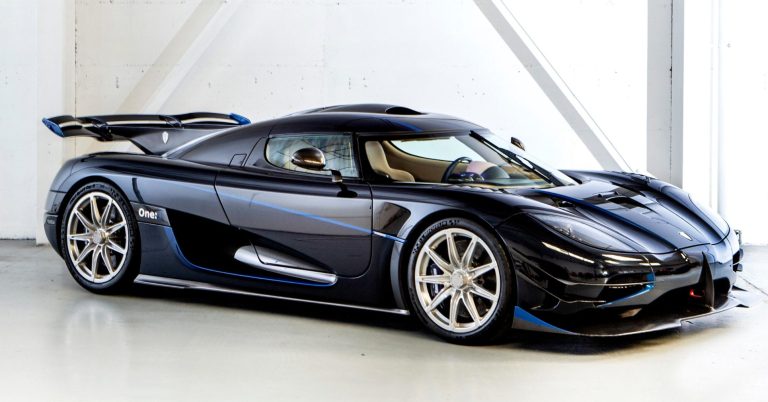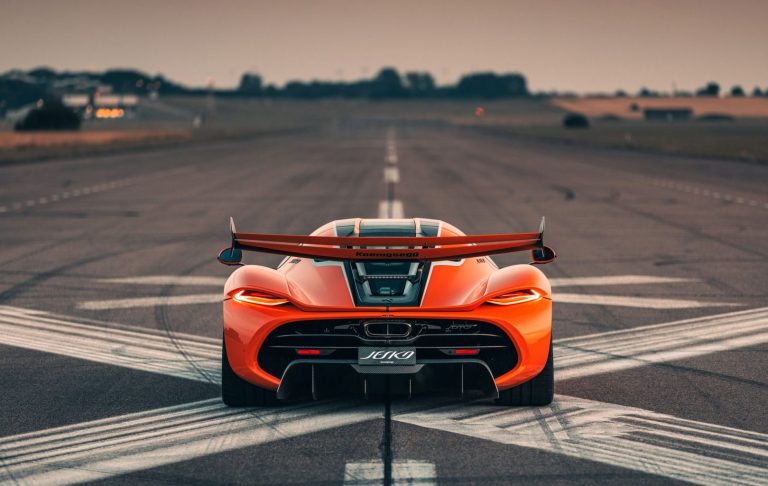0ne:1 2014
The Koenigsegg One:1 made its debut at the 2014 Geneva Motor Show, and all six units were already sold out. It features a version of the 5.0 L twin-turbo V8 engine found in other Agera models, producing a whopping 1,341 hp at 7,500 rpm and 1,371 NM (1,011 lb ft) of torque at 6,000 rpm. The transmission is the same 7-speed dual-clutch paddle shift used in other Agera models. The name One:1 reflects its impressive power-to-weight ratio (1,360 PS to 1360 kg), giving it 1 PS for every kg. With a power output of 1,360 PS, equivalent to one megawatt, Koenigsegg proudly calls the One:1 the 'world's first megacar'. Unlike its predecessors, this car is designed for the track.
Jesko 2020
Launched online on March 3, 2020, alongside the Gemera, the Jesko Absolut is the speed-focused variant of the Jesko, named after Jesko von Koenigsegg, the father of Christian von Koenigsegg. Unlike the Jesko Attack, which features a rear wing, the Absolut opts for two rear fins that significantly reduce downforce from 1,400 kg (3,086 lb) to just 150 kg (331 lb), achieving a sleek drag coefficient of Cd=0.278. The design also eliminates the front splitter and side winglets, smoothing out the front louvers, while the rear wheels come with removable covers to enhance stability at high speeds. Additionally, the car is slightly longer, with a rear extension that adds 85 mm (3 in) to its length. The engine and transmission are the same as those in the Jesko Attack, ensuring that performance remains top-notch. A whopping 3,000 hours went into aerodynamic analysis, complemented by another 5,000 hours dedicated to the design and engineering of the Absolut. Due to the extensive development aimed at reducing drag, the Absolut comes with a higher price tag than the Jesko. The manufacturer estimates that this beast can reach a top speed of 310 mph (500 km/h), with theoretical capabilities soaring as high as 330-350 mph (531–563 km/h).
On 26 June 2024, the Jesko Absolut broke the 0-249 mph (0–400–0 km/h) acceleration record with a time of 27.83 seconds. The record was set at the Örebro Airport, Sweden by factory test driver Markus Lundh
Gemera
The Gemera is set to run on a super compact engine that weighs just 70 kg (150 lb). This engine is so tiny, thanks to its camless piston design using Koenigsegg's Freevalve tech, that it's nicknamed the Tiny Friendly Giant (TFG). It's a three-cylinder powerhouse with a displacement of 1988.25 cc, equipped with two turbos that not only drive the front wheels but also charge the batteries. It cranks out an impressive 590 hp at 7500 rpm, hitting a redline of 8500 rpm, and delivers 600 NM (443 lb ft) of torque between 2000 and 7000 rpm. Plus, there are three electric motors—one for each rear wheel producing 373 kW / 500 hp and 1000 Nm each, and another on the crankshaft generating 298 kW / 400 hp and 500 Nm for the front wheels. Together, they provide a whopping 820 kW / 1,100 hp of electric power, which, when combined with the engine, results in a peak output of 1,268 kW / 1,700 hp. This impressive performance is achieved when using E85 fuel, but the engine is flexible enough to run on various fuels from E100 to regular unleaded. It also boasts cylinder deactivation and claims to be 20% more fuel-efficient than a standard four-cylinder engine of similar size. The 850V 14 kWh battery pack offers a range of 31 miles (50 km), and in hybrid mode, it can stretch that to an impressive 621 miles (1,000 km).
As the first all-wheel-drive car from Koenigsegg, the Gemera comes equipped with all-wheel steering and torque vectoring. True to the brand's style, it boasts a carbon fibre monocoque chassis supported by aluminium sub-structures. Plus, it has an electronically adjustable ride height and a top-notch titanium exhaust system made by Akrapovič.
The Gemera stands out with its unique design, featuring no B-pillar and two impressive dihedral doors that swing open to provide easy access to its luxurious four-seater interior. Inside, you'll find a range of comforts, including four heated and cooled cup holders, advanced driver assistance systems, and a total of four touchscreens—two 13-inch displays in the centre and two more for side and rear view cameras. The infotainment system caters to both front and rear passengers, and there are wireless phone chargers at both ends, along with Apple CarPlay, Wi-Fi, a three-zone climate control system, adjustable seats, and a top-notch audio setup with 11 speakers. Only 300 of these beauties will be made, making it quite exclusive.
Additionally, there's an optional Ghost package that enhances the car's aerodynamics with features like an extended front splitter, S-duct, rear wing, and more. This package is perfect for those who want to take the Gemera's performance to the next level. The I3 version of the Gemera is a powerhouse, boasting a top speed of 249 mph (400 km/h) and an astonishing acceleration from 0 to 62 mph (0 to 100 km/h) in just 1.9 seconds. Even in electric mode, it can reach a top speed of 186 mph (300 km/h), showcasing its incredible engineering and design.
Overall, the Gemera is not just a car; it's a statement of luxury and performance. With its innovative design and high-tech features, it offers a driving experience like no other. Whether you're cruising down the highway or navigating city streets, the Gemera combines style, comfort, and speed in a way that few vehicles can match. It's a limited edition that car enthusiasts will surely want to get their hands on.
CC850
Even though it has a similar name, the CC850 is actually quite different from the original CC8S. Instead, it takes inspiration from the Koenigsegg Jesko, featuring the same multilink suspension setup both in the front and rear. This includes double wishbones and a combination of hydraulic and gas-hydraulic shock absorbers, along with Triplex dampers at the rear. The steering system is a rack and pinion design, and it utilises Koenigsegg's unique 9-speed Light Speed Transmission to deliver power to the rear wheels. The CC850 also introduces the Engage Shifter System, which lets drivers experience manual shifting with a real clutch pedal instead of using paddle shifters. Christian von Koenigsegg has even stated that this feature makes the CC850 potentially the fastest manual car on a racetrack that he can think of. The engine is derived from the Jesko but comes with smaller turbochargers, producing 1,185 hp at 7,800 rpm when using regular fuel, and an impressive 1,385 hp on E85. The peak torque is rated at 1,385 NM (1,022 lb ft) at 4,800 rpm. The wheels are made of forged aluminium, measuring 20" x 9.5" in the front and 21" x 12.25" in the rear, and they are wrapped in Michelin Pilot Sport 4S tyres. For braking, it features 410 mm (16.1 in) 6-piston callipers in the front and 395 mm (15.6 in) 4-piston callipers in the back. The CC850 can hit a top speed between 280-310 mph (450–500 km/h) and accelerates from 0 to 60 mph (0 to 97 km/h) in just 2.5 seconds.
The CC850 was designed as a tribute to the CC8S, marking the 20th anniversary of the initial production of the CC8S. This model was initially restricted to a production run of 50 units in honour of the 50th birthday of the company's founder, Christian von Koenigsegg. However, in response to heightened demand, it was revealed just six days later, on August 25, 2022, that an extra 20 units would be built.









